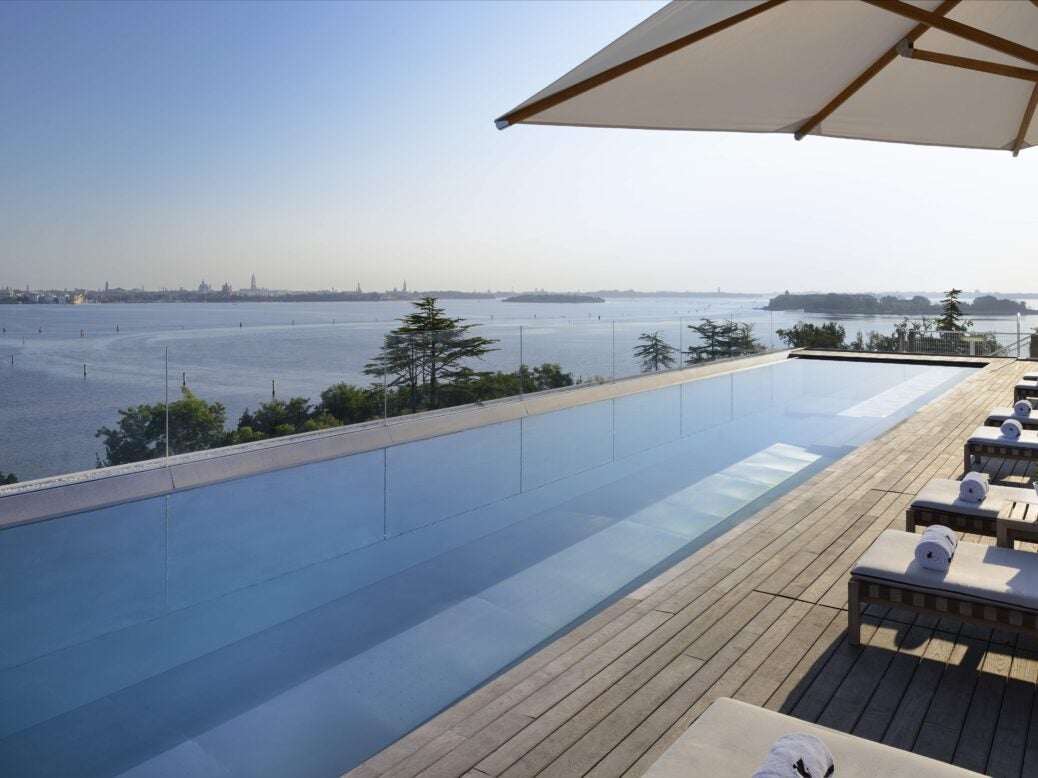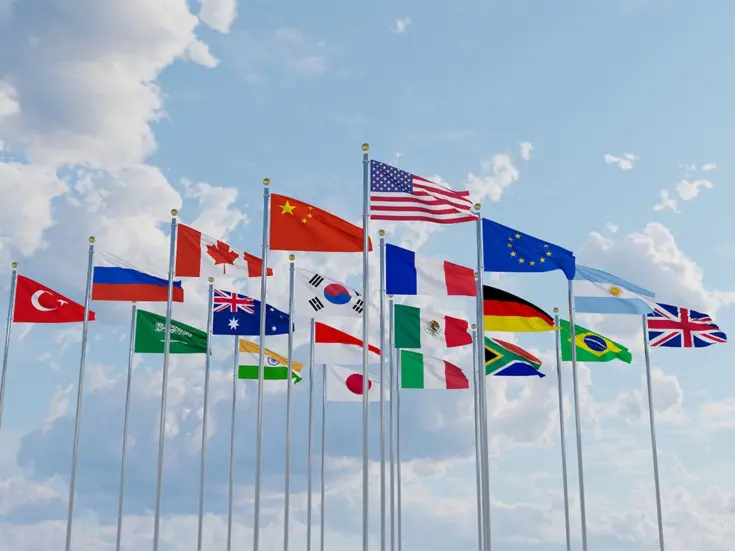
The renovated JW Marriott Resort & Spa is a peaceful island retreat that’s just a short boat ride from the heart of bustling Venice, writes Christopher Silvester.
The island of Sacca Sessola, sometimes known as Isola delle Rose, is one of the islands of the southern Venetian lagoon, around 8km from St Mark’s Square. It was artificially created in 1870 and was first used as a fuel dump, then as a hospital for cholera victims, and later for tuberculosis sufferers. After the hospital closed, the island became a Unesco marine ecology centre for eight years until that too closed. Its latest incarnation is as the JW Marriott Resort & Spa, which took four years of restoration work. Only a couple of minutes away by boat is the Isola di San Clemente, another island that had already been turned into a luxury resort owned by the Kempinski chain.
The island is recognisable from a distance because of its concrete water tower. We arrived by private charter water taxi, a lovely wooden Riva vessel, and disembarked in a boathouse area that resembles a Bond villain’s lair. From there you walk straight up into the resort’s sit-down reception, where a long desk with no fewer than seven stations and armchairs for guests are available at the busiest check-in times.
The resort is a complex of 21 buildings located on 40 acres of land, which includes a century-old park containing 100 olive trees. Isola delle Rose is one of the few Venetian islands with a low wall all around it, which means you can recline on a sun-lounger at the back of the GOCO spa building, for example, and gaze across the lagoon towards the rear of the Giudecca, with your view unimpeded.
There are 200 rooms in the main hotel building, another 66 across the resort, and there are 32 suites in total. Matteo Thun, the architect, has retained the historic walls of some of the original buildings, using ‘box-in-the-box’ construction to enclose contemporary design inside.
La Reserva consists of seven guest rooms, six with private garden and mini-pool plus a view across the lagoon to the city and an outdoor shower; L’Uliveto has 26 guest rooms, each with a small patio, rose bushes, and a view of the olive trees and a small chapel (built in 1921). I stayed in La Maisonette, a terrace of loft suites, each of which has a living room and two bathrooms, a gated front garden and patio. Clean lines and minimalist design are the prevailing interior aesthetic.
The most luxurious offering, the Villa Rose, is a private residence containing three bedrooms, three bathrooms, a living room and a dining room, with a private garden and pool outside.
The staff buzz around on golf carts, cheerily greeting you as they fly past. It is certainly peaceful, the only aural distractions being the birdsong and the faint wheeze of a golf cart’s electric engine.
There are four restaurants on the island, a 24-hour fitness centre, a banqueting building for weddings and gala dinners, and the GOCO spa (the biggest in Venice), whose pool extends from inside to outside.
At the Sapori Cooking Academy, six of us stood at our Gaggenau cooker while executive chef Mauro Taufer showed us how to create four vegetarian dishes during a four-hour afternoon session, and demonstrated invaluable techniques for crisping thinly sliced fennel in iced water, preserving the green colour of avocado purée by placing an avocado stone inside and covering it, frying garlic with its outer skin still on for a subtler flavour, and rolling basil leaves into a cigar shape and cutting them lengthways to create a chiffonade garnish. My favourite dish was cold paccheri (large cylindrical pasta tubes) containing ricotta and flavoured with orange zest, accompanied by a beetroot purée flavoured with garlic, cumin, and turmeric. The six-hour morning Sapori session takes in a visit to Venice’s Rialto vegetable market to pick out ingredients, in addition to a turn in the kitchen.
Breakfast is taken in La Cucina, which can accommodate 170 and has a patio for eating outside. The Rose Bar serves a light menu throughout the day, while the Sagra restaurant, excellent for both lunch and dinner, is adjacent to the hotel’s splendid rooftop pool (heated to 32°C and reserved for adults only) with its spectacular view of the city. Another pool, where children are allowed, is located in the park of olive trees.
The Dopolavoro Dining Room (it translates as ‘after work’), formerly a refectory for the island’s hospital staff and now the resort’s Michelin-starred restaurant, occupies a separate building and has its own private dock for those visiting the restaurant from the city. In a space lined with rustic bricks and under a high ceiling of tarnished mirror panels, chef Federico Bellucci, working under the direction of Giancarlo Perbellini (two Michelin stars), treated our group to a tasting menu that included spaghetti salad with spider crab and coffee, smoked herring risotto, and buckwheat ravioli filled with crème brulée. Bellucci is fond of playful creations, such as a salad with fake olives, one made of tomato, one of a nutty substance. For our wines I chose a Quarz Terlano 2013 Sauvignon and a Le Ragose 2006 Amarone della Valpolicella (at 15.5 per cent volume).
Bellucci has created his own vegetable and herb garden and elsewhere on the island there are 300 fruit trees, from which the staff make marmalade and jams.
The resort’s typical guest has visited Venice before — probably more than once — so they have no need to cram in all the usual tourist activities, although there is a shuttle service to St Mark’s Square every half-hour from early in the morning until 1am. As an old Venice hand, I was happy to spend a couple of days on the Isola delle Rose and make occasional excursions. We visited Murano for a demonstration of glass-making, in which a master glassmaker used pliers to tease a molten lump into a figurine of a prancing horse. Although this was deceptively simple, it’s when you wander through the factory’s showroom of immense chandeliers (typically commissioned by sheikhs and hotels from the Persian Gulf) and other glass objects that you appreciate the complexity of Venetian glassware design.
On the neighbouring island of Burano, we witnessed a veteran lacemaker, at work in the shop of Martina Vidal. She quietly and methodically stitched on to a paper pattern that was resting on a small pillow. As Burano sheds its native sons and daughters at an alarming rate — the population has shrunk by around a third in recent years — one wonders how long crafts such as this will survive. Foreign buyers have been buying up the vacated houses, which are all painted in striking colours because, so legend has it, the island’s fishermen would thereby be able to find their own abodes when wandering home under the influence. The French designer Philippe Starck is said to have five of these houses already: one for him and his wife, the others for guests who visit.
We visited the city proper on our last morning, and as always there are quotidian sights to intrigue. One of the pleasures of Venice is glimpsing how the city functions, so in one of the main shopping streets we saw this deliveryman about to drop off his unconventional load at the Armani store (see left).
During a three-hour visit, we followed a route out of St Mark’s Square towards the Accademia Bridge, crossing the Grand Canal and then weaving our way through the San Polo district to the Scuola San Rocco (with its extensive collection of vast Tintoretto biblical masterpieces), then on towards the Rialto Bridge, re-crossing the Grand Canal, and returning to St Mark’s Square, where we settled in front of Caffè Lavena and listened to its Slovenian house musicians perform their quarter-hour slot (in rotation with those at Caffè Florian and Gran Caffè Quadri).
As we sipped our coffees and delighted in the light classical music, we concluded that we were too blessed to be distressed.








